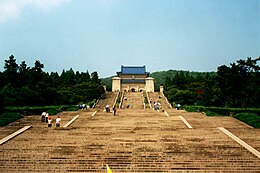Sun Yat-sen mausoleum
The Sun Yat-sen Mausoleum ( Chinese 中山陵 , Pinyin Zhōngshān líng ) is the tomb for Sun Yat-sen , the first President of the Republic of China , whose body lies here in a locked coffin. The mausoleum is located on Purple Mountain in the Chinese city of Nanjing , was built between 1926 and 1929 according to plans by the Chinese architect Lu Yanzhi and opened in August 1933.
history
Shortly before his death, Sun Yat-sen repeated a wish he had previously expressed: “I wish that after my death I would be buried at the foot of the Purple Mountain in Nanjing, where the Provisional Government of the Republic of China was established. And we should never forget the revolution of 1911. ”After his death in 1925, the government organized an architectural competition for a worthy tomb. A commission selected Lu Yanzhi's design (呂 彥 直) because it was based on traditional Chinese buildings. Between 1926 and 1929 the facility was built on the slope of the Purpurberg.
In 1929 the body of Sun Yat-sen was placed in a specially made white marble coffin at the memorial.
It was only after 1949, when the communist government of China increasingly recognized the role of Sun Yat-sen in the founding phase of the republic, combined with a rapprochement with Taiwan , that the mausoleum was presented as a historically significant memorial . Many coaches with tourists drive to the facility every day.
In April 2005, Taiwanese former Kuomintang chairman Lien Chan paid a visit to the mausoleum - the first visit by a Kuomintang leader since the Communists came to power in 1949. In November 2006, Sun's 80-year-old granddaughter, Sun Huiying, visited the mausoleum.
description
The building on the mountain has the shape of an alarm bell, designed in the Chinese pagoda style . Architectural architects see similarities with the monumental tombs of the Chinese emperors, most notably the tomb of the first Ming emperor, Hongwu, which is located about half a mile west on the same slope of Purple Mountain.
The guests first walk through a memory arch at the foot of the facility with the inscription “Bo Ai” (Chinese for “love”). A slightly upward sloping path leads past gardens, accompanied by information boards about the life of the state founder and lined with pine and cypress trees. At the foot of a huge staircase is a pavilion with a plaque in honor of Sun Yat-sen and a nine-meter-high and four-meter-wide stele that contains only four carved Chinese characters. After crossing the pavilion, a staircase 480 meters long and 50 meters wide with 392 steps leads up to the actual mausoleum. Two parts of the staircase in the upper paragraph enclose a bed which is always planted with flowers in the form of symbols. Once at the top, the visitors stand in front of three archways, equipped with symmetrical copper doors that lead into the memorial complex. The temple-like structure is 30 meters long, 25 meters wide and 29 meters high.
In the anteroom there is a 4.60 meter high statue of the seated Sun Yat-sen carved from white marble, the flag of the Kuomintang , a white star on a blue background, forms a ceiling mosaic.
In the main room, the so-called sacrificial hall, is the coffin Sun Yat-sens, the lid of which is adorned with a marble sculpture of the reclining honoree.
The Chinese government had a building adapted in architectural style in the lower area of the memorial complex. In its large hall a second sculpture of the seated Sun Yat-sens was set up, in front of which there is a red carpet. In this room, equipped with red columns and galleries, an honorary formation of the Chinese army in parade uniforms keeps watch during the day , their changing of the guard is celebrated in front of an audience.
In addition to Sun-Yat-sen, his comrades-in-arms Tan Yankai , Deng Yanda , Ōtsuki Kaoru and Lim Nee Soon are buried on the site of the memorial .
Web links
Individual evidence
- ↑ a b Information on the Sun Yat-sen mausoleum at travelchinaguide.com (English) , accessed on April 3, 2015.
- ^ Sun-Yat-Sen Mausoleum at www.chinahighlights.com , accessed April 3, 2015.
- ↑ Yat-sen Mausoleum at orientalarchitecture.com (English) , accessed on April 3, 2015.
Coordinates: 32 ° 3 '51.9 " N , 118 ° 50' 53.8" E


